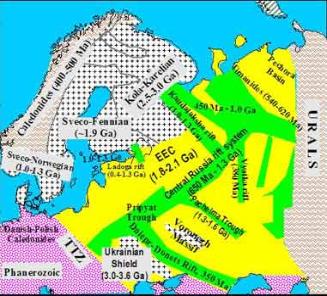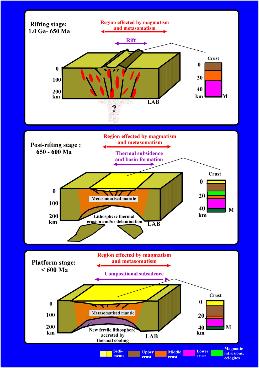| Lithospheric structure, composition, and thermal regime of the East European craton: Implications for the subsidence of the Russian Platform. |
This study seeks to explain subsidence of the Russian platform by
density variations in the lithospheric mantle, here hypothesized to be
related to Proterozoic and Paleozoic rifting. The thermal regime and
density structure of the lithospheric mantle of the EEC are estimated
to show that the Precambrian and Phanerozoic rifting had different
effects on the thermal structure and lithospheric composition, and
consequently on the topography of the basement rocks.
1. Proterozoic rifting resulted in modification of the entire crustal
column of the Russian platform. Regions with a thick (>20 km) upper
crust (5.8<Vp<6.4 km/s) and an almost complete absence of the
middle crust (6.4<Vp<6.8 km/s) are spatially correlated with the
craton-scale Central Russia rift system.
2. Moho temperatures calculated from the surface heat flow data
vary from 350-600 oC in Archean – early Proterozoic terranes to 550-
700 oC in the southern parts of the Russian platform and to 600-850
oC in middle-late Proterozoic regions of the Baltic Shield.
Proterozoic rifting is not reflected in the present thermal regime of the
Russian platform, where lithospheric temperature variations are not
sufficiently pronounced.
Thermal lithosphere of the Russian platform is ~180-210 km thick,
with only slightly smaller values (160-180 km) along the Central
Russia rift system. Paleozoic rifting, however, resulted in a
pronounced lithosphere thinning (to 120-140 km) in the southern parts
of the Russian platform.
density variations in the lithospheric mantle, here hypothesized to be
related to Proterozoic and Paleozoic rifting. The thermal regime and
density structure of the lithospheric mantle of the EEC are estimated
to show that the Precambrian and Phanerozoic rifting had different
effects on the thermal structure and lithospheric composition, and
consequently on the topography of the basement rocks.
1. Proterozoic rifting resulted in modification of the entire crustal
column of the Russian platform. Regions with a thick (>20 km) upper
crust (5.8<Vp<6.4 km/s) and an almost complete absence of the
middle crust (6.4<Vp<6.8 km/s) are spatially correlated with the
craton-scale Central Russia rift system.
2. Moho temperatures calculated from the surface heat flow data
vary from 350-600 oC in Archean – early Proterozoic terranes to 550-
700 oC in the southern parts of the Russian platform and to 600-850
oC in middle-late Proterozoic regions of the Baltic Shield.
Proterozoic rifting is not reflected in the present thermal regime of the
Russian platform, where lithospheric temperature variations are not
sufficiently pronounced.
Thermal lithosphere of the Russian platform is ~180-210 km thick,
with only slightly smaller values (160-180 km) along the Central
Russia rift system. Paleozoic rifting, however, resulted in a
pronounced lithosphere thinning (to 120-140 km) in the southern parts
of the Russian platform.
| Fig. 1. Major tectonic units of the East European Craton and their tectono-thermal ages. Thickness of sediments deposited in different parts of the Russian platform in Proterozoic to Cenozoic varies from ca. 1 km to 20+ km. A peak in sedimentation at 375-215 Ma, synchronous over the entire Russian platform, was related to the Uralian orogeny. Southern parts of the platform affected by Paleozoic rifting continue to subside even in the post-Uralian time. |
3. Buoyancy-based estimates suggest lithospheric density deficit
of ~1.4±0.2% for the Archean-early Proterozoic Finnish Bay -
Kola-Karelian Province. A strong low-density anomaly in the
Kola-Karelian Province (centered over the White Sea) correlates with
seismic velocity anomalies at depths of 200-250 km; a strong density
anomaly in the Finnish Bay (Baltic Sea) correlates with seismic velocity
and attenuation anomalies only down to 100-150 km depth, suggesting
its shallow origin.
Lithospheric density deficit decreases southwards from the Baltic
Shield and is 0.8±0.2 % in most of the Russian platform. In the southern
parts of the Russian platform, that were rifted in the Paleozoic,
lithospheric density is similar to the lithospheric mantle of western
Europe. Regions of less than ca. 0.4-0.6% density anomaly coincide
with the area of post-Uralian subsidence, implying that compositional
modification of the cratonic lithosphere caused post-Uralian subsidence
of the platform.
4. Rifting of the Russian platform has resulted in a decrease of
lithospheric depletion (manifested by an increase of average
lithospheric density), probably due to metasomatism. Proterozoic
thermo-magmatic events might have led to formation of a two-layer
lithosphere due to Fe-enrichment of its lower part. The boundary
between a highly depleted upper and a more fertile lower layers can be
at ca. 90-150 km depth and can produce a seismic pattern similar to the
top of a seismic low-velocity layer.
Paleozoic rifting had a more severe impact on the lithospheric
structure of the Russian platform, leading to compositional modification
and/or detachment of the entire lithospheric column, its further
replacement by younger fertile material, and the consequent, on-going,
subsidence of the southern Russian platform.
of ~1.4±0.2% for the Archean-early Proterozoic Finnish Bay -
Kola-Karelian Province. A strong low-density anomaly in the
Kola-Karelian Province (centered over the White Sea) correlates with
seismic velocity anomalies at depths of 200-250 km; a strong density
anomaly in the Finnish Bay (Baltic Sea) correlates with seismic velocity
and attenuation anomalies only down to 100-150 km depth, suggesting
its shallow origin.
Lithospheric density deficit decreases southwards from the Baltic
Shield and is 0.8±0.2 % in most of the Russian platform. In the southern
parts of the Russian platform, that were rifted in the Paleozoic,
lithospheric density is similar to the lithospheric mantle of western
Europe. Regions of less than ca. 0.4-0.6% density anomaly coincide
with the area of post-Uralian subsidence, implying that compositional
modification of the cratonic lithosphere caused post-Uralian subsidence
of the platform.
4. Rifting of the Russian platform has resulted in a decrease of
lithospheric depletion (manifested by an increase of average
lithospheric density), probably due to metasomatism. Proterozoic
thermo-magmatic events might have led to formation of a two-layer
lithosphere due to Fe-enrichment of its lower part. The boundary
between a highly depleted upper and a more fertile lower layers can be
at ca. 90-150 km depth and can produce a seismic pattern similar to the
top of a seismic low-velocity layer.
Paleozoic rifting had a more severe impact on the lithospheric
structure of the Russian platform, leading to compositional modification
and/or detachment of the entire lithospheric column, its further
replacement by younger fertile material, and the consequent, on-going,
subsidence of the southern Russian platform.
Cartoon showing reworking of the cratonic crust and the subcrustal lithosphere of the EEC during Proterozoic, presumably plume-related rifting, accompanied by intensive magmatism and metasomatic reworking of the lithosphere (a). Thermal cooling at the post-rifting stage (b) leads to thermal subsidence and basin formation. Magmatic intrusions accumulate at the crustal base and at the mid-crustal level, increasing thickness of the upper crust. Ductile middle crust can be squeezed sidewards. The lower part of the lithospheric mantle (from the base up to a 100-150 km depth) is metasomatised and may be removed by thermal erosion and/or by delamination of a dense lowermost lithosphere. Further subsidence (c) is a result of fertilization of cratonic lithosphere during mantle-plume interaction and involves a much larger area than affected by rifting. This process is accompanied by an accretion of a new basal part of the lithosphere, with the fertile composition typical for Phanerozoic regions. If the whole density deficit in the subcrustal lithosphere of the Russian platform (which is ca. 50% of a typical density deficit of the Archean-early Proterozoic lithosphere) (Fig. 4a) is concentrated in its upper part, presumably unmodified by Proterozoic metasomatism, the lower half of the cratonic root has been replaced since the Proterozoic. In this case one may expect a sharp compositional boundary at a depth of ca. 90-150 km from depleted to Fe-enriched composition. This provides an alternative explanation for the 8o seismic discontinuity (the top of a low-velocity zone observed in several cratons at ca. 100 km depth [Thybo et al., 1996) as the base of ancient depleted lithosphere. LAB = lithosphere-asthenosphere boundary. |
| Last modified June, 2006; irina@geol.ku.dk |
Artemieva I.M., 2003.
Earth Planet. Sci. Lett.,
v. 213, 429-444, 2003.
Earth Planet. Sci. Lett.,
v. 213, 429-444, 2003.

Irina Artemieva: Research highlights
- THE CONTINENTAL LITHOSPHERE




